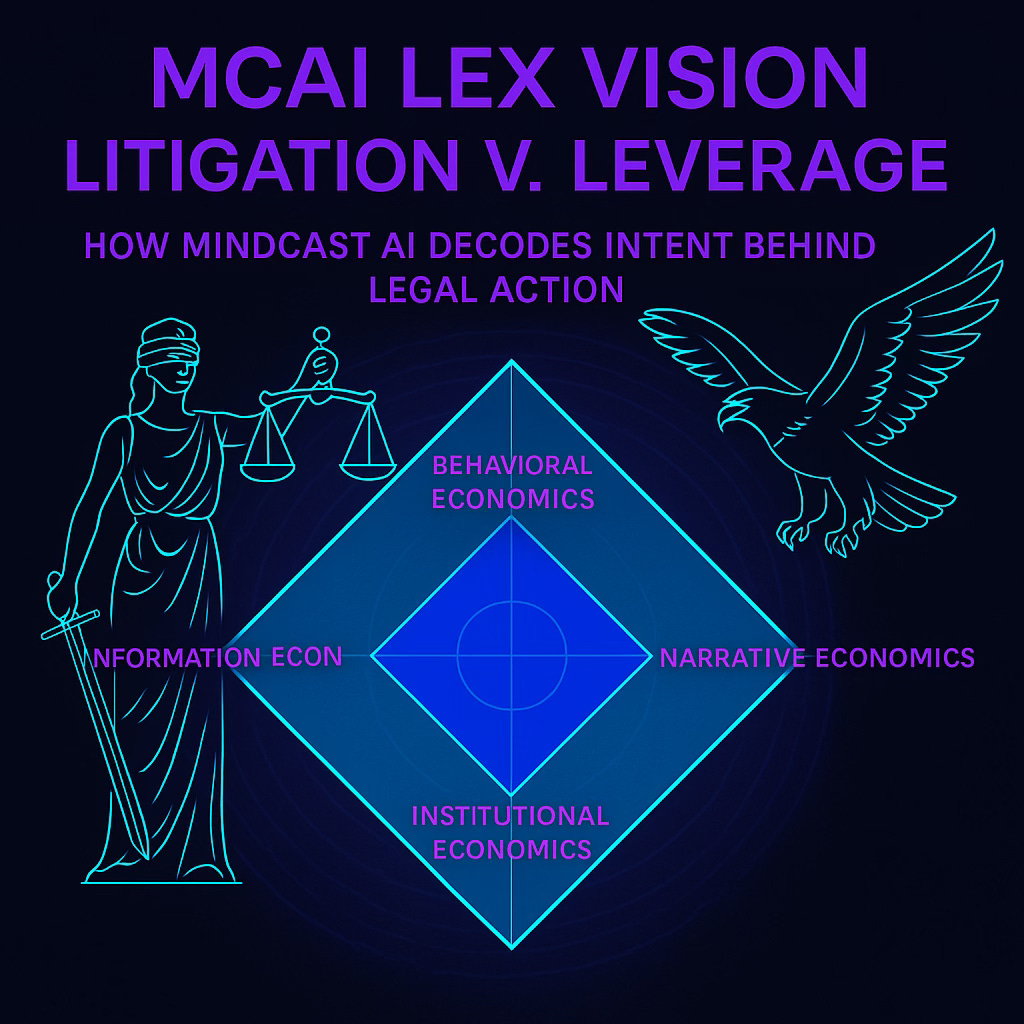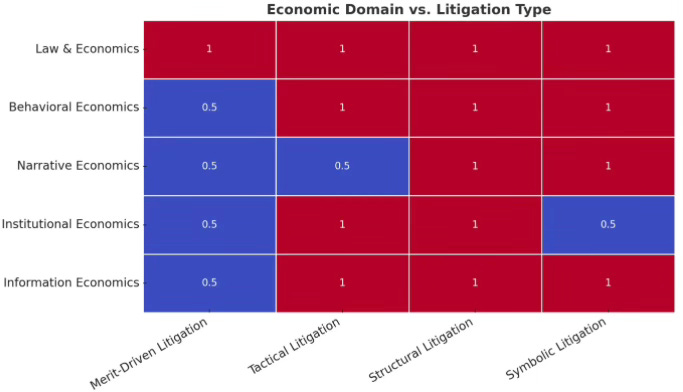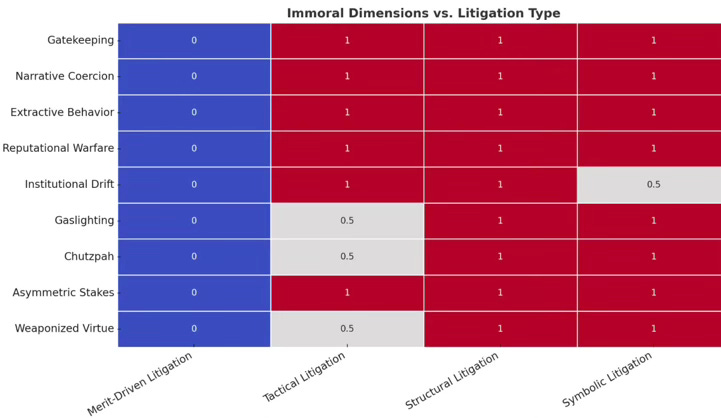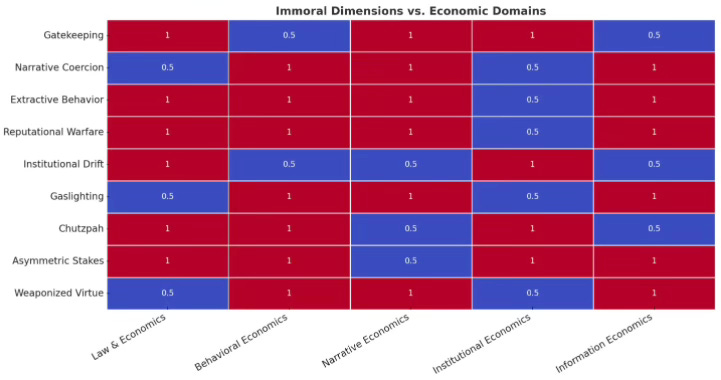MCAI Lex Vision: Litigation v. Leverage, How MindCast AI Decodes Intent Behind Legal Action
Using Cognitive Simulation and Economic Analysis to Distinguish Merit-Based Claims from Narrative Warfare
I. Executive Summary
Legal action is no longer always about winning on the merits. Increasingly, litigation is used to intimidate, reframe narratives, and inflict reputational costs. MindCast AI LLC (MCAI) simulates the intent behind lawsuits, distinguishing between merit-based claims and those designed to manipulate public perception, suppress dissent, or project power.
We will turn this white paper into a standardized framework to assess and score litigation based on its character. By simulating the economic, cognitive, and reputational dimensions behind a legal action, MCAI can determine whether a claim is merit-driven or strategically manipulative. In turn, this analysis informs both defense strategy and public relations posture, enabling institutions to respond proportionally to the true intent behind litigation.
MCAI reveals what traditional legal systems cannot: when a lawsuit is an instrument of control rather than a pursuit of justice. Through layered simulation, moral diagnostics, and economic alignment, MCAI separates litigation from leverage—and trust from coercion.
Insight: Non-merit litigation types are structurally and cognitively aligned with immoral tactics. Immorality emerges not just from intent, but from how actors exploit institutional design and narrative channels—validating MCAI's multi-domain simulation model.
Case Studies:
Loomer v. Maher – Legal-Narrative Analysis: A defamation lawsuit modeling how litigation may be used to distort truth, impose reputational cost, and strategically reframe public narratives.
Lively v. Baldoni – Strategic Legal Brief: A high-profile defamation case exploring reputational warfare, moral asymmetry, and narrative manipulation through legal form.
Musk v. OpenAI – Executive Legal Brief: A landmark institutional dispute illustrating how narrative framing and procedural transparency intersect with trust economics.
Trump-era Title VI Threats – Narrative Economics Analysis: An institutional case showing how litigation threats were used to enforce ideological compliance through narrative control.
II. Strategic Litigation: Beyond the Merits
Legal systems traditionally evaluate litigation through procedural form and legal merit, but this often fails to reveal the underlying purpose of the action. In many cases, the stated intent of a lawsuit masks an entirely different motive—ranging from economic coercion to reputational damage. MCAI categorizes non-merit litigation into three primary forms:
Tactical Litigation: Aimed at draining resources and chilling behavior. These lawsuits are often filed with weak factual basis but create real costs for the defendant, forcing settlements or withdrawals regardless of merit. The goal is not resolution, but attrition. They often exploit the time sensitivity or resource limitations of the opponent, using the legal system as a tool of strategic harassment. These lawsuits are often filed with weak factual basis but create real costs for the defendant, forcing settlements or withdrawals regardless of merit. The goal is not resolution, but attrition.
Structural Litigation: Uses legal asymmetry to intimidate weaker parties. These cases exploit disparities in access to legal resources, jurisdictional advantages, or procedural complexity to suppress or overwhelm the opposing side. They are especially dangerous in environments where litigation costs serve as deterrents against legitimate defense or public participation. These cases exploit disparities in access to legal resources, jurisdictional advantages, or procedural complexity to suppress or overwhelm the opposing side.
Symbolic Litigation: Recasts narratives and asserts moral dominance. Often filed for media optics or reputational damage, these lawsuits aim to rewrite public perception through the authority of legal action—even when the legal claims are tenuous. The performative dimension becomes more important than the judicial one, allowing actors to maintain public narrative control while legally posturing. Often filed for media optics or reputational damage, these lawsuits aim to rewrite public perception through the authority of legal action—even when the legal claims are tenuous.
These forms rely heavily on emotional, cognitive, and reputational manipulation rather than factual or legal strength. They turn the courtroom into a theater of influence—where the goal is not justice, but control. The result is a distortion of institutional integrity that can erode public trust and weaponize legal systems against their intended function.
Meritless Litigation:
Behavioral Economics and Information Economics show peak activation—indicating strong reliance on cognitive distortion and signal manipulation.
Narrative Economics and Institutional Economics form a secondary layer—highlighting their roles in story control and rule subversion.
III. MCAI Frameworks for Litigation Assessment
MCAI integrates a range of modules to evaluate litigation intent:
Action-Language Integrity (ALI): Detects divergence between public claims and private objectives. It assesses whether the stated purpose of a legal action aligns with its strategic or reputational effects.
Cognitive-Motor Fidelity (CMF): Measures consistency between cognitive goals and actual legal actions. High fidelity suggests coherence between belief and behavior; low fidelity suggests manipulation or opportunism.
Cognitive Trust Signal Module (CTSM): Audits whether a legal actor signals trustworthiness or strategic manipulation. This module gauges whether litigation is used as a signaling device in broader institutional narratives.
Narrative Reflex Index: Scores the degree to which litigation is used to hijack public narratives. It captures emotional triggers, media framing, and perception shaping intended by legal action.
Immoral Dimensions Layer: Tags patterns like gatekeeping, extractive behavior, reputational warfare, gaslighting, chutzpah, asymmetric stakes, weaponized virtue, and institutional drift. Each dimension maps to a distinct form of cognitive or structural abuse within litigation contexts.
IV. MCAI Vision: Cross-Domain Economic Assessment
MCAI evaluates not only the filing of meritless litigation, but also the behavior of those who leverage, encourage, or institutionally support it. These actions often reflect the same underlying economic distortions—manipulating cost structures, narrative dynamics, and trust signals for strategic gain. When political or organizational actors support non-merit litigation, they signal willingness to compromise institutional integrity in exchange for short-term leverage.
Legal systems have long recognized the damage posed by abusive legal behavior. Frivolous litigant statutes—including sanctions for bad faith filings and rules designed to prevent vexatious lawsuits—represent an attempt to codify deterrence. However, these rules often lag behind modern narrative warfare, and they rarely account for coordinated ecosystem abuse or reputational manipulation. MCAI addresses this gap by simulating legal behavior before it is adjudicated, identifying strategic misuse even when it technically complies with procedural rules.
MCAI synthesizes five foundational economic lenses. MCAI evaluates not only the filing of meritless litigation, but also the behavior of those who leverage, encourage, or institutionally support it. These actions often reflect the same underlying economic distortions—manipulating cost structures, narrative dynamics, and trust signals for strategic gain. When political or organizational actors support non-merit litigation, they signal willingness to compromise institutional integrity in exchange for short-term leverage.
MCAI Vision synthesizes five foundational economic lenses:
Law & Economics: Evaluates cost-benefit logic and procedural leverage. It focuses on how legal rules influence behavior and how actors weigh expected costs and benefits when deciding whether to initiate or respond to litigation. This domain explains why meritless litigation persists when it serves a strategic economic interest—especially when the probability of sanction is low and the cost to the opponent is high.
Behavioral Economics: Identifies cognitive biases like loss aversion and motivated reasoning. This domain helps MCAI simulate how litigants may act irrationally under stress, emotion, or social pressure. It also explains why some actors repeatedly pursue frivolous actions despite historical losses, due to perception distortions or narrative attachment.
Narrative Economics: Assesses story contagion and reputation dynamics. It explains how legal actions are framed and consumed in public discourse—often decoupled from legal merit. MCAI uses this lens to simulate the spread and perceived legitimacy of litigation across media environments and public trust channels.
Institutional Economics: Flags rule manipulation and procedural asymmetry. It focuses on how institutional constraints, enforcement gaps, or rule ambiguity can be exploited. MCAI evaluates these factors to identify systemic vulnerabilities that enable strategic litigation abuse.
Information Economics: Measures signal distortion and knowledge asymmetry. This domain explains how legal filings and public statements can obscure intent while creating the illusion of legitimacy. MCAI uses this lens to differentiate high-integrity legal communication from misleading legal signaling.
Economic Domains vs. Litigation Types – Highlights that all litigation types activate Law & Economics, while non-merit types heavily engage Behavioral, Narrative, and Informational Economics.
V. Immoral Dimensions in Litigation
MCAI identifies nine immoral dimensions frequently activated in non-merit litigation. These dimensions are not only behavioral markers but also structural clues—indicators that a lawsuit is serving a function other than genuine dispute resolution. They reveal how legal systems can be subtly hijacked to enforce exclusion, manipulate perception, and apply disproportionate social pressure.
Each immoral dimension represents a distinct form of strategic misalignment between the stated legal claim and the actual objective pursued. Together, they form a diagnostic lens that helps clarify when litigation becomes a tool of influence rather than justice.
Immoral Dimensions vs. Litigation Types – Clearly shows that symbolic and structural litigation consistently map to all immoral dimensions, with tactical litigation closely behind.
Gatekeeping (Access Manipulation): This dimension captures efforts to control who gets to speak, participate, or defend themselves in a legal or public setting. Gatekeeping often appears as procedural exclusion, selective enforcement, or denial of standing. It reflects the use of legal barriers to limit legitimacy rather than uphold it.
Narrative Coercion (Truth Distortion): Narrative coercion refers to lawsuits filed to control or reshape public narratives regardless of factual truth. This includes reframing misconduct as victimhood, or using legal claims to erase contrary evidence. It distorts collective memory and undermines authentic discourse.
Extractive Behavior (Power without Value): This dimension tracks when litigation is used to take advantage of a system or person without contributing meaningfully. Examples include suits filed solely to secure settlements, silence critics, or harvest institutional influence under false pretenses.
Reputational Warfare (Social Cost Imposition): In reputational warfare, litigation is used as a pressure mechanism—imposing public stigma or personal shame. The goal isn’t to resolve a legal issue but to degrade someone’s standing, making them less credible or viable in the public eye.
Institutional Drift (Rule Subversion): Institutional drift occurs when formal rules are followed procedurally but violated in spirit. Litigants may exploit ambiguities, avoid judicial review, or misuse legal process to shift institutional norms and outcomes, often without overt illegality.
Gaslighting (Reality Erosion): Gaslighting weaponizes the court system to undermine the defendant’s sense of reality or truth. A frivolous lawsuit that accuses the target of outrageous but baseless claims can create confusion, self-doubt, and reputational fatigue—often with long-term psychological impact.
Chutzpah (Moral Reversal): This involves flipping the moral equation—where the true aggressor poses as the victim and accuses the defender of misconduct. It reflects shameless inversion of truth, exploiting public sympathy and institutional presumption to achieve narrative dominance.
Asymmetric Stakes (One-Sided Risk): Asymmetric litigation creates disproportionate costs for one party while shielding the other from meaningful consequence. These cases are structured so that the initiator risks little while the defendant absorbs most of the legal, reputational, or financial burden.
Weaponized Virtue (Moral Credentialing): Weaponized virtue refers to the use of social justice language or moral identity to insulate bad-faith actions. Lawsuits in this domain often rely on the plaintiff’s perceived virtue to deflect scrutiny or mobilize public pressure without substantive merit.
These dimensions are notably absent in merit-driven litigation.
Immoral Dimensions vs. Economic Domains – Immoral behavior clusters most densely around Narrative, Behavioral, and Information Economics, with Law and Institutional Economics serving as enablers.
VI. Pattern Analysis Across Simulations
Cognitive Digital Twin Simulation MCAI can generate Cognitive Digital Twin (CDT) flows to model the internal decision logic, values, and behavioral patterns of key litigation actors—plaintiffs, defendants, legal teams, or institutional supporters. These simulations reveal not only stated intentions but also narrative preferences, reputational sensitivities, and strategic forecasting tendencies. CDT flows are especially useful in cases with limited precedent or high reputational volatility, helping stakeholders simulate how a legal actor might behave under stress, scrutiny, or media exposure.
CDTs are formed by integrating the actor’s public statements, litigation filings, known affiliations, and prior decision history. These cognitive models are then run through scenario branches to assess future moves, moral asymmetries, and narrative positioning. In coordinated or pattern-based litigation ecosystems, CDT flow mapping can also detect structural alignment between actors who never formally collaborate but show synchronized behavior across filings.
Forecasting from CDT Simulations Once a Cognitive Digital Twin (CDT) is constructed, MCAI runs predictive scenarios using branching logic informed by past behavior, known incentives, and reputational constraints. These simulations are used to forecast future litigation moves, media escalation, reputational fallout, and potential institutional responses. By modeling each actor’s likely next steps—not just based on legal precedent but on cognitive architecture—MCAI equips institutions to anticipate and mitigate legal and narrative risk before it materializes. This predictive layer transforms CDT from a descriptive tool into a forward-operating risk intelligence system.
MCAI cross-references immoral dimensions, litigation categories, and economic domains to reveal key behavioral patterns. This layered simulation allows us to detect when legal action serves hidden motives, even if it appears procedurally valid on the surface. The result is a multidimensional map of intent, where each type of litigation leaves a distinct ethical and economic footprint. These patterns help distinguish legal strategies designed to resolve conflict from those designed to project power, distort narratives, or impose cost without substance.
Below, we define the character of each type of litigation based on repeated activation patterns across MCAI simulations:
Merit-Driven Litigation: Scores clean across all immoral dimensions. Anchored in legal-economic integrity. These cases exhibit internal coherence between claim and intent, supported by evidence, rule compliance, and sincere engagement with legal norms. They are filed to resolve disputes, uphold rights, or clarify law—not to intimidate, distract, or dominate.
Symbolic and Structural Litigation: Highly correlated with immoral behaviors like gaslighting, gatekeeping, and reputational warfare. These cases often carry moral overtones or political theater, disguising attempts to control public perception or entrench institutional power. Symbolic claims may be factually weak but emotionally potent, while structural suits use legal leverage to suppress opposition through procedural dominance.
Tactical Litigation: Activates extractive and asymmetry domains—used for deterrence, not adjudication. These suits are filed with the intent to drain time, impose financial costs, or chill speech. They often rely on delay, volume, or complexity to exhaust defendants and discourage resistance—even when the underlying claim lacks substance.
*Cross-Domain Diagnostic Table: This diagnostic model shows where different forms of litigation intersect with behavioral economics and systemic moral stress. It demonstrates that immoral litigation behaviors are not random but pattern-driven, often encouraged by the structure of modern legal and media ecosystems. Immoral behavior emerges where narrative, behavioral, and information economics converge. Law & Institutional Economics identify the structural enablers.
VII. Use Case: Institutional Integrity & Strategic Defense
MCAI's litigation assessment framework is not purely diagnostic—it is tactical. Institutions facing legal pressure need more than reactive defense; they require predictive clarity. By simulating the intent behind litigation before it escalates, MCAI allows decision-makers to see beyond the surface of legal filings and into the motivations and reputational stakes behind them. This proactive intelligence enables smarter coordination between legal, communications, and governance teams.
This framework supports:
Litigators seeking to expose coercive lawsuits. MCAI flags litigation that diverges from evidentiary standards or shows intent to impose reputational harm. This allows litigators to argue not only on legal grounds but on behavioral integrity. The system can generate brief-aligned summaries that highlight narrative manipulation, pressure tactics, or asymmetric legal threats.
Institutions defending against reputation-based legal aggression. MCAI reveals when a lawsuit is designed to undermine brand legitimacy, suppress internal whistleblowing, or redirect public perception. By identifying these patterns early, institutions can mobilize their legal, public relations, and compliance teams with unified messaging and response plans.
Watchdogs & media interpreting litigation motives. For journalists, public interest attorneys, and civil rights observers, MCAI provides structured insight into whether litigation is being weaponized. It helps shift public understanding from outcome-based coverage to motive-aware interpretation, encouraging deeper institutional accountability.
Scoring litigation character allows for actionable insight into legal posture, reputational threat, and narrative risk. It enables:
Defense planning calibrated to the real threat (not the surface claim). MCAI uncovers hidden motives and escalation triggers embedded in legal filings. Legal teams can tailor their strategy to avoid reputational landmines, anticipate narrative twists, and maintain judicial credibility.
Public relations strategy rooted in truth signal, not noise. MCAI enhances communication by aligning legal response with institutional values. When litigation is used to distort or distract, organizations can respond with messaging that reclaims the narrative, rooted in cognitive and moral clarity.
This use case framework underscores MCAI’s broader value: bridging the gap between legal strategy and institutional truth-telling. It ensures organizations don’t just survive litigation—they respond with integrity, foresight, and control.
VIII. Legal System Response: Frivolous Litigant Laws in Practice
To illustrate the limitations and evolving role of traditional legal deterrents, we consider three examples:
California's Vexatious Litigant Statute – Cal. Code Civ. Proc. §391 et seq.
California maintains a list of individuals who repeatedly file meritless claims. Once designated a vexatious litigant, a person must obtain judicial approval before filing new suits. While effective in isolating extreme abuse, this law often misses narrative-driven or institutionally shielded bad actors, especially in reputational or political conflicts. MCAI supplements this by identifying abusive patterns of behavior rather than just individuals.
Washington State Frivolous Action Statute – RCW 4.84.185
Under RCW 4.84.185, Washington courts may award attorneys’ fees to the prevailing party if a civil action is found to be frivolous and advanced without reasonable cause. While the law offers some deterrent effect, it is rarely invoked against coordinated narrative abuse or bad faith litigation cloaked in procedural legitimacy. MCAI detects institutionalized misuse of legal filings that appear facially valid but fail under deeper simulation.
Federal Rule of Civil Procedure 11
Rule 11 allows federal courts to sanction attorneys or parties for filings that are frivolous, legally unreasonable, or intended to harass. Though this rule has teeth, enforcement is uneven, and parties often avoid sanction by couching coercive suits in the language of legal plausibility. MCAI highlights the intent-behavior divergence even when formal filings appear compliant.
These examples underscore the gap between procedural deterrence and strategic simulation. MCAI is designed to bridge this gap, scoring intent before harm manifests.
IX. Conclusion: From Legal Action to Cognitive Weapon
Litigation is no longer merely a legal process—it is a cognitive, reputational, and strategic event. As legal actions increasingly function as instruments of influence, intimidation, or distortion, traditional frameworks fail to capture the true intent behind filings. MCAI fills this gap by simulating decision-making logic, strategic goals, and narrative alignment, delivering insights far beyond procedural analysis.
This framework empowers institutions to distinguish legitimate legal risk from manufactured reputational assault. It enables them to calibrate legal defense and communications strategy to the actual motive behind a lawsuit—not just its surface claims. In doing so, MCAI helps organizations respond with coherence, integrity, and foresight across both judicial and public domains.
Prepared by Noel Le, Founder and Architect of MindCast AI, a predictive cognitive simulation platform designed to decode legal intent, institutional behavior, and strategic decision-making. His work sits at the intersection of behavioral economics, law and economics, and narrative intelligence—building systems that model how cognition, power, and perception shape real-world outcomes. Noel holds a J.D. and has extensive experience in legal strategy, regulatory analysis, and AI architecture. His research focuses on litigation modeling, foresight systems, and reputation intelligence.






